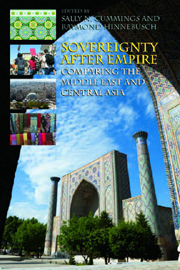Book contents
- Frontmatter
- Contents
- Acknowledgments
- Notes on the Contributors
- 1 Introduction
- SECTION I Histories of Empire and After
- SECTION II Paths to Sovereignty: Views from the Core and Periphery
- SECTION III Empire and Domestic Sovereignty
- SECTION IV Empire and Popular Sovereignty
- 10 Culture, Colonialism and Sovereignty in Central Asia
- 11 Culture in the Middle East: The “Western Question” and the Sovereignty of Post-imperial States in the Middle East
- 12 Pathways of Islamist Mobilization against the State in the Middle East and Central Asia
- SECTION V Empire and External Sovereignty
- Bibliography
- Index
10 - Culture, Colonialism and Sovereignty in Central Asia
from SECTION IV - Empire and Popular Sovereignty
Published online by Cambridge University Press: 12 September 2012
- Frontmatter
- Contents
- Acknowledgments
- Notes on the Contributors
- 1 Introduction
- SECTION I Histories of Empire and After
- SECTION II Paths to Sovereignty: Views from the Core and Periphery
- SECTION III Empire and Domestic Sovereignty
- SECTION IV Empire and Popular Sovereignty
- 10 Culture, Colonialism and Sovereignty in Central Asia
- 11 Culture in the Middle East: The “Western Question” and the Sovereignty of Post-imperial States in the Middle East
- 12 Pathways of Islamist Mobilization against the State in the Middle East and Central Asia
- SECTION V Empire and External Sovereignty
- Bibliography
- Index
Summary
In 1970, the Uzbek Soviet Socialist Republic was preparing to celebrate the 2500th jubilee of the city of Samarkand. As part of the official celebrations, the Samarkand Theater of Opera and Ballet had produced an opera, “The Legend of Bibihanum,” based on a well-known local legend about one of the wives of the medieval ruler, Amir Timur (Tamerlane). The theater had chosen this theme because the legend had an epic quality well suited to opera, and because it resonated strongly with Soviet understandings of the importance of Samarkand's Timurid-era architecture. Samarkand's despotic history was problematic for Soviet ideology, but the symbols of civilizational achievements created by the despots (the name Bibihanum also refers to the architectural complex that is named after Timur's wife) were international icons of which the Soviet state was proud. Here, it would seem, was an ideal enactment of Soviet ideas about culture: the European high art genre of opera would facilitate the fullest expression of the cultural development of the local people, while the theme of the opera would synthesize perfectly the principle of “national in form, socialist in content,” by communicating Soviet values through the medium of a local legend. However, in spite of the seeming acceptability of this theme given the dual constraints of Soviet ideology and common knowledge about the significant monuments and historical events of Samarkand, there was a fatal flaw in the story that halted the opera's production in its tracks. The flaw in the story was that it could not avoid the topic of the world-conquering Timur himself.
- Type
- Chapter
- Information
- Sovereignty after EmpireComparing the Middle East and Central Asia, pp. 199 - 221Publisher: Edinburgh University PressPrint publication year: 2011



